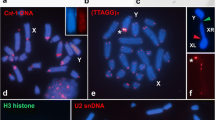Abstract
The system of nucleolar controlled sex-chromosome segregation which characterises Xyp species of hide beetles is also present in the one species (haemorrhoidalis) with an XY system. This, coupled with the fact that the karyotype in the XY species is asymmetrical, whereas species with smaller y-chromosomes show greater symmetry, suggests that “erosion” of the y may have involved translocation of the material of the y onto the autosomes rather than simple loss. Finally, supernumerary y chromosomes present in laboratory cultures of two species (maculatus and frischii) demonstrate the efficiency of the sex nucleolus as a mechanism for securing segregation.
Similar content being viewed by others
References
Darlington, C. D.: Theg enetical and mechanical properties of the sex chromosomes V. Cimex and the Heteroptera. J. Genet. 39, 101–137 (1939).
— and K. Mather: The elements of genetics. London: Alien & Unwin 1952.
Dyer, A. F.: Allocyclic segments of chromosomes and the structural heterozygosity that they reveal. Chromosoma (Berl.) 13, 545–576 (1963).
Hinton, H. E.: A monograph of the beetles associated with stored products: No 1. British Museum (Natural History). London 1945.
John, B., and G. M. Hewitt: The B-chromosome system of Myrmeleotettix maculatus II. The statics. Chromosoma (Berl.) 17, 121–138 (1965);- A polymorphism for heterochromatic supernumerary segments in Chorthippus parallelus. Chromosoma (Berl.) 18, 254–271 (1966).
—, and K. R. Lewis: Nucleolar controlled segregation of the sex chromosomes in beetles. Heredity 4, 431–439 (1960).
Lewis, K. R., and B. John: The organisation and evolution of the sex multiple in Blaps mucronata. Chromosoma (Berl.) 9, 69–80 (1957).
Madel, W.: Zur Kenntnis der Biologie einiger Dermestes-Arten. Ent. Bl. 37, 107–111 (1941).
Manna, G. K., and S. G. Smith: Chromosomal polymorphism and inter-relationships among bark weevils of the genus Pissodes Germar. Nucleus (Calcutta) 2, 179–208 (1959).
Smith, S. G.: Chromosome numbers of Coleoptera. Heredity 2, 31–48 (1953);- The cytogentic basis of speciation in Coleoptera. Proc. Xth Int. Congr. Genetics 1, 444–450 (1909);- Chromosome numbers of Coleoptera II. Canad. J. Genet. Cytol. 2, 67–88 (1960);- Cytogenetic pathways in beetle speciation. Canad. Entomologist 94, 941–955 (1962);- Cytological species separation in asiatic Exochomus (Coleoptera: Coccinellidae) Can. J. Genet. Cytol. 7, 363–373 (1965);- Heterochromatin, colchicine and karyotype. Chromosoma (Berl.) 16, 162–165 (1965).
Stebbins, G. L.: Longevity, habitat and release of genetic variability in the higher plants. Cold Spr. Harb. Symp. Quant. Biol. 23, 365–378 (1958).
Suomalainen, E.: Die Polyploidie bei dem parthenogenetischen Blattkäfer Adoxus obscurus L. (Coleoptera, Chrysomelidae). Zool. Jb., Abt. Ökol., Geogr. u. System., 92, 183–195 (1965).
Swift, H.: Studies on nucleolar function, p. 266–303: In: A symposium on molecular biology. Chicago: Chicago University Press 1959.
Takenouchi, Y.: A further chromosome survery in thirty species of weevils (Curculionidae, Coleoptera). Jap. J. Zool. 12, 139–155 (1958).
Ullerich, F. H., H. Bauer u. R. Dietz: Geschlechtsbestimmung bei Tipuliden (Nematocera, Diptera). Chromosoma (Berl.) 15, 591–605 (1964).
Virrki, N., and C. M. Purcell: Four pairs of chromosomes: the lowest number in Coleoptera. J. Hered. 66, 71–74 (1965).
Wahrman, J.: A carabid beetle with only eight chromosomes. Heredity 21, 154–159 (1966).
White, M. J. D.: Sex-chromosomes and meiotic mechanisms in some African and Australian mantids. Chromosoma (Berl.) 16, 521–547 (1965).
Wolf, E. B.: Y-chromosom und überzählige Chromosomen in den polytänen Somakern von Phryne cincta Fabr. (Diptera, Nematocera). Verh. Dtsch. Zool. Ges., 1961, S. 110–123.
Author information
Authors and Affiliations
Rights and permissions
About this article
Cite this article
John, B., Shaw, D.D. Karyotype variation in dermestid beetles. Chromosoma 20, 371–385 (1967). https://doi.org/10.1007/BF00394261
Received:
Issue Date:
DOI: https://doi.org/10.1007/BF00394261




